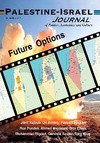The ongoing debates about the future options facing the Palestinian-Israeli conflict have centered almost exclusively around the two-state solution or the bi-national state, and have not given other scenarios due attention. Therefore, in this issue of the Palestine-Israel Journal, we are addressing the question: What are the future options facing Palestinian-Israeli bilateral relations? Is the two-state paradigm still possible and achievable? If the answer is negative, are we then heading towards the bi-national state? And are these the only alternatives? If not, what other options can be considered, and how feasible or realistic are they? What are their pros and cons? And will they be able to stem an escalation in violence and bloodshed and reactivate the political process?
At present, Israel has the upper hand. It will impose further restrictions and collective punishment. And with the absence of a political solution based on the two-state option, a situation will arise whereby, between the Mediterranean and the Jordan River, a majority of Palestinians will find itself controlled by a Jewish minority. This will lead to the creation of an apartheid system reminiscent of the former South African regime.
Other options such as the hudna (ceasefire) proposed by Hamas - which means Israel will have to withdraw from all the territories occupied in 1967, including East Jerusalem, in return for a hudna - will not be accepted by Israel. Similarly, the long-term interim arrangement with continued Israeli control of the occupied territories, and the continued expansion and building of Jewish settlements, will not be accepted by the Palestinians.
Do we wait to see how events will unfold, or do we shape our destiny ourselves? This is the challenge. The Israeli population is increasingly leaning in the direction of the two-state solution. Yet, at the same time, the Israeli government and all its relevant organs are working around the clock to undermine that option by persisting in their settlement activities. Some Israelis argue that the deepening hatred and lack of trust have damaged the possibility of reaching a final settlement. Is this a valid position, or is it only an excuse to justify their rejection of withdrawal - the basis for the achievement of a permanent peace with their Palestinian neighbors and the recognition of their rights?
Answers to these and other questions are debated in this issue. But we will leave it to our readers to draw their own conclusions about what is possible and what is not, and about what should be implemented and what should be unanimously repudiated and denounced.
* * *
The Palestine-Israel Journal congratulates former Editorial Board members Lamis Alami and Riad Malki on being appointed the Palestinian Authority's Minister of Education and the Minister of Information, respectively. While we regret their departure from our Editorial Board, we wish them the best in their endeavors.
* * *
The images on pages 22 and 55 are from Desert Generation - a joint exhibit commemorating 40 years of the occupation, featuring the works of Israeli and Palestinian artists who oppose the occupation and call for its immediate end.

